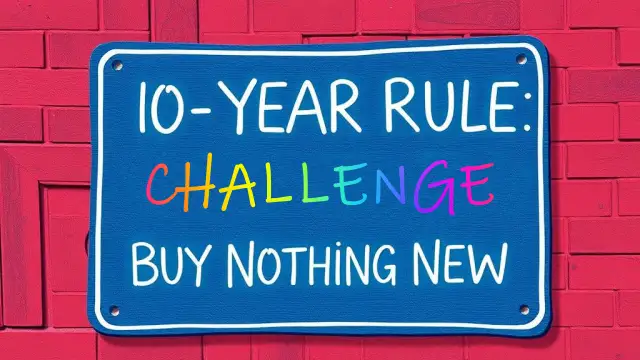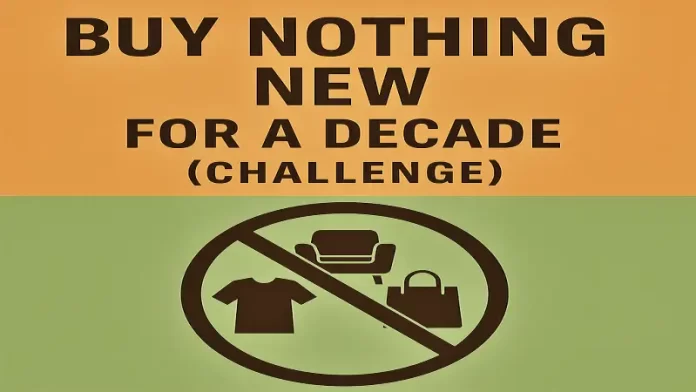Alright, let’s throw a wild idea out there, something that might make your eyebrows shoot up to your hairline. Imagine this: for the next ten years, you buy nothing new. No new clothes, no new gadgets, no new furniture, no new books. Zip. Zilch. Nada. That’s the core of the “10-Year Rule” challenge.
Sounds completely bonkers in our hyper-consumerist, “add to cart”, doesn’t it? Maybe a little terrifying? Or… maybe, just maybe, a tiny part of you is intrigued. Could this be the ultimate personal stand against a system that often feels like it’s gobbling up the planet? Is it a radical path to a more sustainable and meaningful life, or just a recipe for a very frustrating decade?
Let’s unpack this audacious challenge, explore what it really means, why anyone in their right mind would attempt it, and what it could actually achieve. Buckle up; this is a journey into the heart of anti-consumption.
Table of Contents
What in the World Does “Buy Nothing New for a Decade” Actually Mean? The Nitty-Gritty
Before we go any further, lets get specific. “Nothing new” sounds absolute, but for any challenge like this to be even remotely feasible, there needs to be some ground rules. Clarifying the parameters are crucial.
Typically, challenges like this focus on durable goods things that aren’t consumed or used up quickly. So, what’s usually excluded (i.e., you CAN still acquire these, ideally still mindfully)?
- Food & Groceries: Obviously. You gotta eat!
- Consumables: Think soap, toothpaste, toilet paper, cleaning supplies. Though many attempting this might also explore low-waste/DIY options here too.
- Medicine & Healthcare: Non-negotiable. Health comes first.
- Experiences: Travel, concerts, classes these are often seen as alternatives to material consumption.
- Gifts (Receiving): You can’t always control what others give you, though you can communicate your preferences. Giving gifts yourself would mean gifting secondhand, handmade, or experiences.
So, we’re primarily talking about: clothes, electronics, furniture, books, home décor, cars (a big one!), toys, non-essential gadgets, etc. For ten whole years. The idea is to source everything in these categories through means other than buying brand new from a retailer.
What about digital purchases? Subscriptions? This is where personal definitions come in. Some might allow digital book purchases if they’ve sworn off physical new books, while others might extend the “no new” to digital products as well, seeking out free/open-source software or library e-books. It’s a personal line to draw in the sand.

Why on Earth Embark on Such an Extreme Quest? The Driving Forces
Taking on a decade challenge of this magnitude isn’t a casual decision. It stems from some pretty deep motivations:
- Radical Environmentalism: This is the big kahuna. Choosing to buy nothing new is a powerful way to drastically reduce your personal contribution to resource depletion, the carbon emissions of manufacturing and shipping, pollution, and the mountains of waste piling up in landfills. It’s a direct, personal intervention in the linear “take-make-dispose” economy.
- Financial Liberation: Imagine the money saved! Not buying new clothes, gadgets, or cars for ten years would free up a significant amount of cash. This could go towards paying off debt, investing, funding experiences, or achieving early retirement. Its a surefire way to boost your savings.
- A Powerful Anti-Consumerism Statement: It’s a deeply personal and visible rejection of the relentless marketing messages that tell us we need more, newer, better to be happy. It’s a way to say “enough” to fast fashion, planned obsolescence, and the cult of the new.
- Unleashing Resourcefulness & Creativity: When “buying new” isn’t an option, you have to get creative. You learn to repair things, repurpose old items into something new, make things yourself, or find ingenious ways to meet your needs without a shopping trip. This skill-building are incredibly empowering.
- Cultivating Deep Mindfulness & Intentionality: Every potential acquisition becomes a carefully considered decision. Impulse buys become a thing of the past. You start to truly understand the difference between a “need” and a “want.”
- Strengthening Community Bonds: This challenge often pushes people towards engaging more with their local communities borrowing from neighbors, joining tool libraries or repair cafes, participating in clothing swaps, and supporting local secondhand shops.
For many, it’s a combination of these factors a holistic attempt to live more lightly on the planet, more freely in their finances, and more richly in their skills and relationships.
The “How-To” Playbook: Strategies for a 10-Year “Buy Nothing New” Marathon
Okay, so you’re intrigued. Maybe even a little tempted (or terrified). How would one even begin to tackle such a monumental anti-consumption decade? It requires a complete shift in mindset and habits, but here are the key strategies:
- Embrace the Secondhand Universe: This becomes your new retail world.
- Thrift Stores & Charity Shops: Obvious starting point for clothes, housewares, books.
- Consignment Shops: Often have higher-quality, curated secondhand clothing and furniture.
- Online Marketplaces: eBay, Facebook Marketplace, local equivalents like OLX or Craigslist incredible resources for almost anything.
- Antique Stores & Flea Markets: For unique finds, furniture, and decor.
- Garage Sales & Estate Sales: Can unearth real treasures.
- Become a Repair Ninja: The mantra is repair, don’t replace.
- Learn basic skills: sewing buttons, patching jeans, simple furniture fixes, basic electronics troubleshooting (YouTube is your friend!).
- Support local repair shops: cobblers, tailors, electronics repair technicians. Advocate for the “Right to Repair.”
- The Art of Borrowing & Swapping:
- Libraries: Not just for books! Many now lend tools, seeds, museum passes, and more.
- Tool Libraries: A growing movement offering community access to tools.
- Clothing Swaps: Organize one with friends or find local events.
- Friends, Family, Neighbors: Don’t be afraid to ask to borrow something you only need occasionally.
- Get Your DIY On:
- If you have skills in sewing, woodworking, knitting, etc., now’s their time to shine! If not, it’s a great decade to learn.
- Making gifts instead of buying them adds a personal touch.
- Rent for Occasional Needs:
- Need a specific power tool for a weekend project? Rent it. Formal wear for a one-off event? Consider renting.
- The “Allowed List” & Graceful Exits: This is crucial for long-term adherence.
- Define upfront what, if anything, you will allow yourself to buy new if absolutely no safe or functional secondhand option exists. Common examples include:
- Underwear & socks (though some make/repair these too!)
- Safety equipment (e.g., bike helmets, car seats for children secondhand safety can be risky)
- Essential medical items
- Specific hygiene products without viable alternatives
- The key is honesty with yourself and sticking to your pre-defined rules. Without some exceptions, the challenge might feel to daunting for most.
- Define upfront what, if anything, you will allow yourself to buy new if absolutely no safe or functional secondhand option exists. Common examples include:
The Not-So-Easy Street: Potential Challenges & Pitfalls
Let’s not sugarcoat it: a 10-year buy nothing new challenge would be hard. Really hard.
- The Time Suck: Finding specific items secondhand, repairing things, or DIYing takes considerably more time and effort than a quick click on Amazon.
- Availability & Specificity Issues: Need a very specific part for a repair or a particular item of clothing in your size? The secondhand market might not deliver it quickly, or at all.
- Social Gymnastics: Dealing with societal norms around gift-giving (both giving and receiving) can be awkward. Explaining your choices to friends and family might get tiring. Navigating gift giving require careful communication.
- Skill Deficiencies: Not everyone is a natural at repairs or DIY. There’s a learning curve, which can be frustrating.
- The Siren Song of “New”: We’re conditioned to desire new things. Resisting that constant barrage of marketing and the allure of a shiny, new object can be emotionally taxing.
- Unexpected Needs: Life throws curveballs. What if something essential breaks and a quick, new replacement is the most practical (though not ideal) solution in a pinch?
A Decade of Deprivation? Or a Thought Experiment with Wings?
Is a strict, no-exceptions, 10-year rule realistic for most people? Probably not. Very few individuals have documented completing such a lengthy and stringent challenge successfully.
But maybe that’s not the point. Perhaps the true value of the 10-Year Rule lies in its power as an aspirational goal or a radical thought experiment. It forces us to confront the absurdity of our current consumption levels and to seriously consider what “enough” truly means.
Even if you don’t go the full decade, the principles can inspire massively impactful changes:
- A “Buy Nothing New Year”: A 12-month challenge is much more attainable and can still be life-changing.
- Category-Specific Challenges: “No new clothes for a year,” “no new electronics for two years.”
- Mindful Pauses: Simply committing to a 30-day “cooling off” period before any non-essential new purchase.
The core idea is to break the habit of mindless consumption and build new pathways of acquiring and using things.
The Ripple Effect: If We All Bought (Much) Less New Stuff
Imagine if a significant portion of the global population adopted even a modified version of this challenge. The collective impact could be a game-changer:
- Dramatically Reduced Demand for Virgin Resources: Less mining, logging, drilling.
- A Thriving Repair & Secondhand Economy: More jobs in repair, resale, and refurbishment. This create a more circular flow of goods.
- Shift Towards Durability in Manufacturing: If people aren’t buying new constantly, companies would be incentivized to make products that last and are repairable.
- A Cultural Shift Away from Disposability: Valuing longevity, craftsmanship, and resourcefulness over novelty and trendiness. It could really throw a spanner in the works of industries like fast fashion.
The Verdict: Is the 10-Year Rule the Answer?
The 10-Year Rule: Buy Nothing New for a Decade challenge is an extreme proposition, no doubt. It’s a personal Everest of anti-consumption. But within its daunting framework lie some profound truths about sustainable living, mindful spending, and the pursuit of a more meaningful existence beyond material accumulation.
While a full, rigid decade might be out of reach for many, the spirit of the challenge is incredibly valuable. It pushes us to question, to innovate, to connect, and to become more resourceful. It encourages us to see waste not as an endpoint, but as a failure of imagination.
So, could you do it? Maybe. Maybe not for ten years. But could you try for one year? Six months? Could you pick one category of “new” to eliminate? Every efforts, big or small, to consume more consciously makes a difference. The 10-Year Rule, even as a thought experiment, invites us to redefine our relationship with “stuff” and that, in itself, is a powerful step towards a healthier planet.

